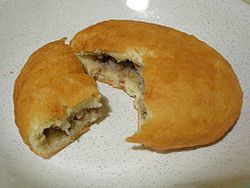Suddsekoek
 Segokoek from K'undzeti | |
| Alternative names | Bodenskoek, Diplomaatje, Broodje Diplomaten, Hartige Oliekoek, Vistari Donut |
|---|---|
| Type | Doughnut |
| Course | Snack |
| Place of origin | Vistaraland |
| Serving temperature | Hot |
| Main ingredients | Yeast dough, Prinsaren or Marelte cheese, Meat |
| Variations | Cream cheese, Chillies, Segokoek |
A Suddsekoek, known by a variety of regional names, is a Vistari savoury doughnut filled with cheese, most often locally sourced Prinsaren or Marelte, as well as meat. In Vistaraland itself, the term can broadly refer to any type of savoury doughnut, as opposed to oliekoek or olykoek, a sweet doughnut. This distinction between doughnuts exists in several languages within the KVC, with Olykoek notably a common term used in several dialects of Wesalaric, replacing doughnut in the dominant vernacular.
The meat most commonly inside a suddsekoek has changed considerably over the years, with the import of pulled pork and the introduction of Satay meats from the Vistari West Pacific having both made significant impacts on the range of meat provided.
History
Due to the high price of sugar throughout the early period of Vistari unification, the ability to have sweet doughnuts was very limited amongst the lower and middle classes, bringing prominence to a number of savoury varieties filled with meat, cheese, vegetables or mushrooms. Over time, these savoury doughnuts became notably associated with travel and food for long journeys over land, increasing the popularity of Prinsaren inside early suddsekoek due to the cheese's ability to travel and age well. Traditionally, the doughnuts were fried over an open fire, allowing them to be used as a snack eaten while camping, where more complex meals would not be available until a stop was made at a permeant settlement.
As imports from Valerijk lowered the price of sugar for the Vistari middle class, fruit-preservative filled oliekoek began to supersede the savoury variety, with doughnuts including mushrooms or vegetables being given a heavily negative association with the destitute. However, this had a lessened affect on the meat and cheese-filled suddsekoek which remain popular today. Due to its association with travellers and compatibility with what would become the conceptual base for fast food, the suddsekoek was spread significantly across Vistari Imperial holdings, adapting and occasionally adopting the variety of flavours and preparations used for cooking meat in different areas, becoming a staple of the Vistari and colonial working classes.
As such, traditional celebrations which extolled humility and unity, especially days of Saints, generally began adopting the practice of serving foods like suddsekoek to those of all social backgrounds as a way of bringing about community, with such holidays often sarcastically referred to by the colloquial term Koekdagen - or "Cake Days", as a way in which to comment on the wealthy being out-of-touch with the common people, represented by their use of expensive meat in the making of suddsekoek which originated as a show of equality.
Names and variations
While Suddsekoek and translations thereof are the most recognized way to refer to the food internationally, however there are a number of regional variants and names for the snack across the Vistari-speaking world.
The name Suddsekoek, derived from the phrase Suddsekaap Koek (lit. 'Suddsekaap cake'), is the one most commonly used in Nieuwhuis, especially Molensland and Koersland, coming from the belief that the fried snack originated from the City or its surrounding regions. There is notably very little historical evidence for such a claim, however, and the claim generally has not been adopted in Suddsekaap itself.
In Suddsekaap, as well as the majority of Southern Vistaraland, the name Bodenskoek is used, with Boden referring to messengers, likely arising from the affiliation the doughnut had with travellers and therefore groups such as diplomats and messengers. In the same vain, the names Diplomaatje and Broodje Diplomaten (lit. 'Diplomat's Bun') are used in the Duchy of Eindrivier.
Within the region of Sereena as well as the Western Provinces, there is often no distinction made between savoury and sweet Doughnuts, due to the popularity of the savoury variety. As such, they are usually referred to as simply Oliekoek, or Hartige Oliekoek to specify. The more internationally recognized term Donut has also been adopted in several regions, with the term "Vistari Donut" having been used to advertise them by some companies.
In K'undzeti and the Vistari West Pacific, a from of Suddsekoek with rice is commonly eaten. When this was brought back to other areas of the Empire, it gained the name Segokoek, adopting the native Zetian word for rice. In certain areas of Valerijk, chilli peppers are used in order to provide additional flavour to the snack, most commonly the Jalapeño. In northern regions of Valerijk, the cheese is occasionally replaced for cream cheese. Such a variation has additionally been seen in the country of Wessæria, reportedly due to its popularity with Hilma van Kuiperseiland, the Vistari-born Consort of Valheret Hallsey I. This claim has been disputed however, with some noting the popularity of cream cheese - also known as thick cheese - in the area, due to it having been believed to originate from the nearby Zemeprievadai.